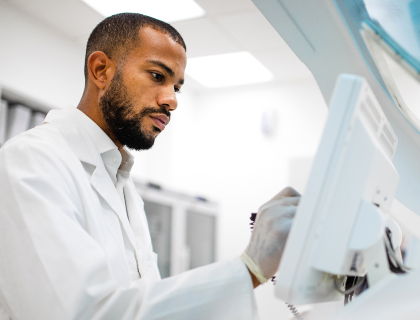How Viral Vectors Drive CAR T-Cell Therapy

Posted by:
Fabian Eckermann
Published on:
Jul 3, 2025
CAR T-cell therapy is a groundbreaking treatment for patients with blood cancers. Genetic modification of a patient’s own T-cells reprograms these to specifically target and destroy cancer cells. Viral vectors are at the heart of this cutting-edge technology and deliver the genetic information needed to turn T-cells into effective cancer killers.
Viral vectors are essential for CAR T-cell therapy
T-cells from a patient are modified to express chimeric antigen receptors (CAR). These engineered cells can then identify and eliminate cancer cells expressing the target antigen. The genetic engineering step is fundamental to the therapy’s success – and viral vectors are the most widely used tool for achieving this.
Viral vectors act as a shuttle to deliver the genetic information for the CAR into the genome of the T-cells. They provide efficient, stable gene transfer, which is critical for CAR expression in T-cells. Lentiviral or gamma-retroviral vectors are most commonly used due to their high transduction efficiency and ability to drive stable gene expression.
How are viral vectors produced?
The production of viral vectors is a complex, tightly controlled biomanufacturing process designed to ensure safety, consistency, and regulatory compliance.
- Design and clone the CAR transgene: First, the CAR construct needs to be cloned into a lentiviral transfer plasmid.
- Prepare the packaging system: Viral vectors are most commonly produced using four plasmids and a producer cell line. The transfer plasmid encodes CAR, the envelope plasmid contains genes for proteins that appear on the virus surface, the packaging plasmid contains core viral components minus genes for viral replication, and the rev plasmid has the viral rev protein.
- Co-transfect the producer cell line with all four plasmids: This co-transfection ultimately generates viral particles that are used to introduce the CAR gene into T-cells by transduction.
The driving force of CAR T-cell therapy
Each step in the vector development process directly impacts the safety, efficacy, and scalability of CAR T-cell therapies. As the field advances, continued innovation in vector design and manufacturing will be key to expanding access and improving patient outcomes.
Automating production of a CAR T-cell therapeutic within a continuous system – from the selection of T-cells from the patient’s serum through to the selection and isolation of the activated cells – would make personalized cancer treatments faster, safer, scalable, and more cost-effective.
Redefining what is possible in life sciences and diagnostics
Automating personalized therapies, such as CAR T-cell therapy, is particularly challenging. A large number of complex devices are needed throughout the multi-step process.
Furthermore, the cell material provided by patients is also extremely valuable and the reproducibility and reliability of treatments must be ensured.
We have a deep understanding of the automation needed for the various steps in the process, from T-cell selection and genetic modification to cell expansion and infusion. Our unique approach overcomes the challenges as we always think about device technology and biological processes together.
This mutual understanding between engineers and scientists is crucial for the development of a successful diagnostic device.

What exactly is CAR T-Cell Therapy?
CAR T-cell therapy is a form of immunotherapy against cancer in which the patient's own T-cells are genetically modified in the laboratory to recognise and attack cancer cells. The therapy aims to modify the immune system.

Revolutionizing Blood Cancer Treatment in CAR T-Cell Therapy
CAR T-cell therapy is a new treatment primarily used for certain types of blood cancers. This innovative approach is making significant strides in the medical field, offering hope to patients with challenging diagnoses.

Inside CAR T-Cell Therapy: Progress and Pitfalls
CAR T-cell therapy has revolutionized treatment of hematological malignancies, driving the enormous growth in CAR T-cell research. But while results are highly encouraging, the treatment involves multiple complex steps.

CAR T-Cell Therapy: The Next Frontier
What started as a groundbreaking treatment for certain types of leukemia, lymphoma, and multiple myeloma is now laying the foundation for a new era of personalized medicine.
Don't miss the next part of our blog series that will focus on the breakthroughs and new horizons of CAR T-cell therapy. Follow us on LinkedIn and be the first to hear about it!
